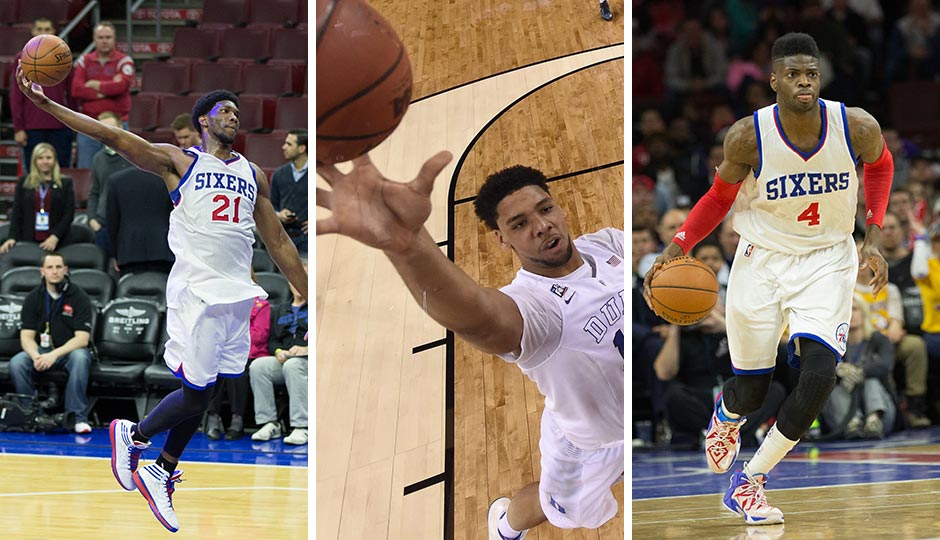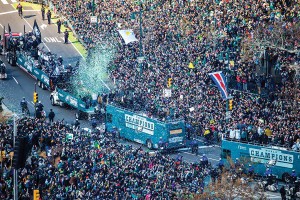There Are Two Ways for Sixers Fans to Look at the Jahlil Okafor Pick

Joel Embiid (left) and Nerlens Noel (right) | Bill Streicher, USA Today Sports. Jahlil Okafor (center), Chris Steppig, NCAA Pool, USA Today Sports
Basketball writer Derek Bodner is covering the NBA draft for Philadelphia magazine at Sixers Draftland.
The results of Thursday night’s NBA draft left many Sixers fans confused about the direction of the team.
It also left many fans hopeful for the team’s future.
The drafting of Jahlil Okafor — who was thought of by most to be one of the three best prospects in the draft and one of the few who could legitimately be expected to turn a franchise around — can be looked at in two ways, both of which have some merit:
Viewpoint One: Three’s a Crowd
Some fans who are hoping for the Sixers to have something that resembles a cohesive team, with a defined core going forward, could be feeling disappointed. The Sixers have an unorthodox, unbalanced roster, with three top-6 picks — 2013’s No. 6 pick Nerlens Noel, 2014’s No. 3 pick Joel Embiid, and Okafor, this year’s No. 3 — invested in players who play largely the same position, and few perimeter players of merit.
There are people — myself included — who question whether those three franchise centerpieces can fit together in the long term. It’s not even the fact that they’re all frontcourt players, as there are 96 minutes available per game between the power forward and center positions, which means there’s more than enough time for all three to play, assuming their skills are complementary and that one of them is comfortable putting aside his ego to come off the bench.
But whether their skill sets can indeed complement each other is a far more serious a question than whether the Sixers have too much frontcourt depth. Can Noel develop into a good enough shooter and keep the lane from being too congested for the other two big men — both of whom have incredible post-scoring potential — to operate at maximum efficiency? Can Okafor move his feet well enough on the perimeter to keep Noel and Embiid near the hoop defensively, where their shot-blocking is most valuable? Ultimately, will the presence of one devalue the skills of another?
They’re all fair questions to which we don’t have answers at this time. With those question marks come a level of uncertainty that is unsettling for a chunk of the fan base that very much wants the future to come into focus.
Essentially, if you wanted a blueprint for how the Sixers will look when they’re ready to contend, Thursday night’s NBA draft didn’t provide you with that.
Viewpoint Two: Franchise Above All
However, there is another viewpoint prevalent among Sixers fans that paints Thursday night’s results in a much more positive light. If you believe that the worst position for the Sixers in a year or two from now is to be without a franchise player — or at least without a player on the roster who looks destined to become one — then drafting of Okafor mitigates the chances of that worst-case scenario.
The problem of acquiring a franchise player, by the way, is a historically tough one to solve. In the last 30 years the Sixers have had exactly two franchise-level players, Charles Barkley and Allen Iverson, with long periods of irrelevance in between.
The NBA, through restricted free agency, through capping how much free agents can earn, and by allowing teams to go over the salary cap to offer their own free agents maximum deals, has created a system where salary cap space alone is not enough to make a team a relevant destination for top-tier talent looking to change teams.
Instead, teams have to be attractive for players who want to win. That attractiveness can come from a multitude of factors, but frequently it comes down to the opportunity to join other elite players, although not necessarily rookies, even highly touted ones.
“I think they often want to be shown the results first. I think they’re all excited about rookies, and they’re excited about young players, but I think they’re even more excited about players they’ve competed against and that they’ve seen up close,” Hinkie said, when talking about impact free agents. “If you’re 30 years old, you might say ‘Let me let this thing sift out a little bit’.”
The hope, then, becomes that the highly touted rookies the Sixers are drafting blossom into the types of dominant players that the team can use as recruiting chips to lure other impact players to join them.
“The players [in free agency] have to make their own decision, and it’s often the money is exactly equal, or largely similar,” Hinkie explained. “They have to make decisions about what kind of market they want to play in, and we often help with that. About what kind of coach they want to play for, and we often help with that.
“The biggest decision they make is ‘Who are they going to play with? What player on their team is so good that they know the two of them, me and him, can win?'”
In essence, in order to attract a top-20 player, you need a top-20 player already on roster. The NBA has done too good of a job in preventing money from being a differentiating factor to be otherwise. That’s the problem the Sixers are trying to solve: Get a player that other great players want to play with.
Whether talking about Stephen Curry and Golden State or Dirk Nowitzki and Dallas, whether you look at the presence of Dwyane Wade being necessary to lure LeBron James to Miami or Kyrie Irving being necessary to convince LeBron to return home to Cleveland, superstars attract other superstars, and those original superstars almost always come from the draft.
Getting that caliber of a player is practically the Sixers’ sole focus at this stage of their rebuild — it’s bordering on obsession. Progress, in the minds of Sam Hinkie and his staff, is measured almost exclusively by whether they’re succeeding in that regard.
The rest, including wins and losses, and filling out the roster with complementary pieces before he knows who they’re going to complement, is largely seen as noise. If the Sixers win more games, but aren’t any closer to acquiring, and developing, a franchise talent, then the Sixers quite simply don’t view that as meaningful progress.
It’s a philosophy I generally agree with. It’s an environment that the league has created with its free agency rules, and a reality the Sixers have to operate within.
Viewed through that lens, Thursday night’s NBA draft can be seen as a success. While Okafor has some questions on the defensive side of the court, he has the ability to be a legitimate focal point on the offensive end. He’s the type of guy that defenses will have to gameplan for, and who can use that attention to make his teammates better.
Better to Be Lucky
And here’s the thing: Those very same rules that make teams without a great player reliant on the draft also make building a dynasty possible, perhaps more-so than any other sport. Restricted free agency — and the ability to match any contract for a four-year player coming off of a rookie contract — all but guarantees a team can have their drafted superstar for the majority of his physical prime. Bird rights, and the ability to go over the salary cap to sign your own free agent, allows teams in bad financial situations to retain their superstars, even if they’ve mismanaged their cap. Capping how much great players can earn makes them underpaid assets, and allows multiple superstars to fit under your salary cap to form a superteam, if you’ve managed your finances well.
If one of the Sixers’ big men emerge as a legitimate franchise player, and there’s a case to be made that the possibility is real, then the Sixers have accomplished step one — the hardest step — toward NBA relevancy. They’ll need some luck to get there, as most franchises do. It’s fun to speculate where the Golden State Warriors would be if Minnesota didn’t select two point guards ahead of Steph Curry, or where Cleveland would be if they hadn’t gotten incredibly lucky on their 1.7% chance to win the lottery last year, which allowed them to get Kevin Love, and become more attractive to LeBron James.
And make no mistake, the Sixers will need a little bit of luck. Whether that luck comes in the form of Joel Embiid’s health, or Noel developing an offensive game beyond what others have projected, or ping pong balls in 2016 falling the Sixers’ way, most great franchises are built on the backs of a combination of luck, and then capitalizing on that luck.
But, because the league stacks the deck in favor of teams with young superstars on their roster, if the Sixers are able to accomplish this first step they’ll be on the path to profit from the flawed system that makes them so desperate now.
So, if the results of this week’s NBA draft has the Sixers closer to having a franchise player on their roster, it’s a great success, even if the blueprint for the team is not yet clearly defined. If the concern is whether two of Okafor, Embiid, and Noel remain healthy and turn out to be superstars, well, that’s a problem I think the Sixers brass are willing to live with.
Second-Round Disappointment?
The selection of Okafor at No. 3, behind Karl-Anthony Towns and D’Angelo Russell, is hard for me to criticize. I had Okafor rated third on my big board that I released before the draft, right behind Towns and Russell, after all.
The second round, however, was a little bit of a head-scratcher.
It’s not so much the selection of European prospects Arturas Gudaitis at No. 47 and Luka Mitrovic at No. 60 that bothers me, even though they’re likely to remain in Europe for the foreseeable future. The odds of second-round picks working out are low, which means the Sixers want to get as many chances to get lucky as they can.
That strategy presents some complications, however, as the Sixers have a fixed number of roster spots and, perhaps more importantly, minutes available to evaluate, and develop, these players. The Sixers instead want to draft European players who will remain overseas, continue to get playing time, but who the Sixers maintain control over and can eventually bring over at specified intervals if they develop more than expected and turn into viable NBA players. It’s a strategy that allows the Sixers to buy as many chances as possible to get lucky in the second round without running into roster size and playing time bottlenecks.
The head-scratching part was their 35th selection, which the Sixers traded for future second-round selections in 2020 and 2021.
Replenishing the cupboard with future second round picks isn’t the worst idea in the world, as the picks are frequently used not just to draft players, but also as sweeteners in trades. The Wizards, for instance, used two second-round picks to move up from 19th to 15th in this past draft, and the T-Wolves added a second round selection to the 31st pick in the draft to move up to 24th. In this regard, having more future picks to trade makes some sense, and just wasting a selection on a player, if you don’t have confidence in the players available, can be a waste.
But, to me, the 35th pick in the draft was too (relatively) valuable of an asset, and future second round picks too easy to acquire, to do that in this instance. Whether the Sixers could have somehow found a way to combine second round picks to move back up into the first round, or just used the 35th pick to select from one of the flawed, but interesting, prospects available, such as guard Joseph Young or shooting guard Norman Powell, either outcome would have been preferable in my mind to trading the selection away for picks so far off in the future.
Follow @DerekBodnerNBA on Twitter.
Previously in Sixers Draftland:
• Jahlil Okafor Looks to Exceed High Expectations
• Joel Embiid Not Expected to Play In Summer League
• Sixers Trade With Knicks, Get Future Second-Round Picks
• Richaun Holmes, J.P. Tokoto Highlight Sixers’ Second-Round Picks
• The Sixers Select Jahlil Okafor With the No. 3 Pick
• Sixers Draftland: 2015 NBA Draft Liveblog
• Who Are the Sixers’ Second-Round Options?
• Report: D’Angelo Russell to Lakers a Smokescreen
• Report: Celtics Putting Together a Huge Offer for No. 3 Pick
• Draft Day Mock Roundup: The Experts’ Best Guesses on Who The Sixers Will Take
• Reports: Sixers Targeting Rashad Vaughn; Is Trading Down a Possibility?
• 2015 NBA Draft Big Board: The 10 Best Prospects for the Sixers
• Report: Sixers Locked In on D’Angelo Russell?
• Rumor Mill: Sixers Reportedly in Discussions to Acquire Another First-Round Pick
• Justise Winslow: A Defensive Maverick With Big “O” Questions
• Dario Saric Not Coming Over This Season
• Mario Hezonja: Is Elite Shooter Confident… or Cocky?
• Emmanuel Mudiay: The Point Guard With a Shooting Problem
• Kristaps Porzingis: International Man of Mystery
• NBA Mock Draft Roundup: Who the Experts Think the Sixers Will Take
• D’Angelo Russell: The Guy Everyone Thinks the Sixers Are Drafting
• Jahlil Okafor: One of the Best Low-Post Scorers We’ve Seen
• D’Angelo Russell to Work Out for the Sixers After All
• Karl-Anthony Towns: The Big Man the Sixers Probably Want — and Likely Can’t Get
• Does Joel Embiid’s Setback Change Sixers’ Draft Plans?
• Welcome to Sixers Draftland


